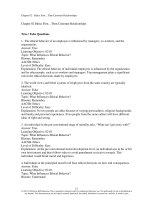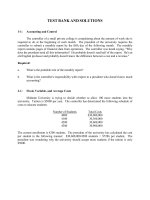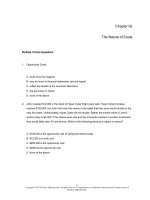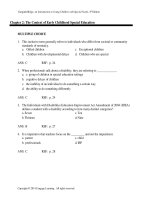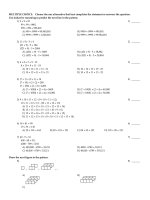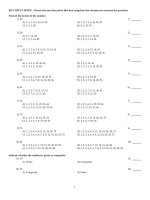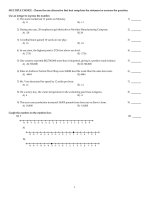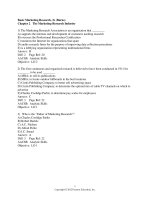Starting out with java from control structures through data structures 2nd edition gaddis test bank
Bạn đang xem bản rút gọn của tài liệu. Xem và tải ngay bản đầy đủ của tài liệu tại đây (99.99 KB, 11 trang )
Gaddis: Starting Out with Java: From Control Structures through Data Structures, 2/e
© 2012 Pearson Education
Chapter 2
MULTIPLE CHOICE
1. To compile a program named First, use the following command
a. java First.java
b. javac First
c. javac First.java
d. compile First.javac
ANS: C
2. A Java program must have at least one of these:
a. Class definition
b. Variable
c. Comment
d. System.out.println(); statement
ANS: A
3. The ___________ is normally considered the standard output and standard input devices, and usually refer to the
monitor and keyboard.
a. CRT
b. CPU
c. secondary storage devices
d. console
ANS: D
4. If the following Java statements are executed, what will be displayed?
System.out.println("The top three winners are\n");
System.out.print("Jody, the Giant\n");
System.out.print("Buffy, the Barbarian");
System.out.println("Adelle, the Alligator");
a. The top three winners are
Jody, the Giant
Buffy, the Barbarian
Adelle, the Alligator
b. The top three winners are
Jody, the Giant\nBuffy, the BarbarianAdelle, the Alligator
c. The top three winners are Jody, the Giant\nBuffy, the BarbarianAdelle, and the Albino
d. The top three winners are
Jody, the Giant
Buffy, the BarbarianAdelle, the Alligator
ANS: D
5. This is a value that is written into the code of a program.
a. literal
b. assignment statement
c. variable
Gaddis: Starting Out with Java: From Control Structures through Data Structures, 2/e
d.
© 2012 Pearson Education
operator
ANS: A
6. What would be printed out as a result of the following code?
System.out.println("The quick brown fox" +
"jumped over the \n"
"slow moving hen.");
a. The quick brown fox jumped over the \nslow moving hen.
b. The quick brown fox jumped over the
slow moving hen.
c. The quick brown fox
jumped over the
slow moving hen.
d. Nothing. This is an error.
ANS: D
7. Which of the following is not a rule that must be followed when naming identifiers?
a.
b.
c.
d.
The first character must be one of the letters a-z, A-Z, and underscore or a dollar sign.
Identifiers can contain spaces.
Uppercase and lowercase characters are distinct.
After the first character, you may use the letters a-z, A-Z, the underscore, a dollar sign, or digits 09.
ANS: B
8. Which of the following is not a primitive data type?
a. short
b. long
c. float
d. String
ANS: D
9. Which of the following is valid?
a. float y;
y = 54.9;
b.
float y;
double z;
z = 934.21;
y = z;
c.
float w;
w = 1.0f;
d.
float v;
v = 1.0;
Gaddis: Starting Out with Java: From Control Structures through Data Structures, 2/e
ANS: C
10. The boolean data type may contain values in the following range of values
a. true or false
b. -128 to + 127
c. - 2,147,483,648 to +2,147,483,647
d. - 32,768 to +32,767
ANS: A
11. Character literals are enclosed in _____; string literals are enclosed in _____.
a. single quotes; single quotes
b. double quotes; double quotes
c. single quotes; double quotes
d. double quotes; single quotes
ANS: C
12. What is the result of the following expression?
10 + 5 * 3 - 20
a.
b.
c.
d.
-5
5
25
-50
ANS: B
13. What is the result of the following expression?
25 / 4 + 4 * 10 % 3
a.
b.
c.
d.
19
5.25
3
7
ANS: D
14. What will be displayed as a result of executing the following code?
int x = 5, y = 20;
x += 32;
y /= 4;
System.out.println("x = " + x + ", y = " + y);
a.
b.
c.
d.
x = 32, y = 4
x = 9, y = 52
x = 37, y = 5
x = 160, y = 80
© 2012 Pearson Education
Gaddis: Starting Out with Java: From Control Structures through Data Structures, 2/e
ANS: C
15. What will be the value of z as a result of executing the following code?
int x = 5, y = 28;
float z;
z = (float) (y / x);
a.
b.
c.
d.
5.60
5.6
3.0
5.0
ANS: D
16. What will be the displayed when the following code is executed?
final int x = 22, y = 4;
y += x;
System.out.println("x = " + x +
", y = " + y);
a.
b.
c.
d.
x = 22, y = 4
x = 22, y = 26
x = 22, y = 88
Nothing, this is an error
ANS: D
17. In the following Java statement what value is stored in the variable name?
String name = "John Doe";
a.
b.
c.
d.
John Doe
The memory address where "John Doe" is located
name
The memory address where name is located
ANS: B
18. What will be displayed as a result of executing the following code?
int x = 6;
String msg = "I am enjoying this class.";
String msg1 = msg.toUpperCase();
String msg2 = msg.toLowerCase();
char ltr = msg.charAt(x);
int strSize = msg.length();
System.out.println(msg);
System.out.println(msg1);
System.out.println(msg2);
System.out.println("Character at index x = " +
ltr);
System.out.println("msg has " + strSize +
© 2012 Pearson Education
Gaddis: Starting Out with Java: From Control Structures through Data Structures, 2/e
"characters.");
a.
I am enjoying this class.
I AM ENJOYING THIS CLASS.
i am enjoying this class.
Character at index x = e
msg has 24 characters.
b.
I am enjoying this class.
I AM ENJOYING THIS CLASS.
i am enjoying this class.
Character at index x = e
msg has 25 characters.
c.
I am enjoying this class.
I AM ENJOYING THIS CLASS.
i am enjoying this class.
Character at index x = n
msg has 24 characters.
d.
I am enjoying this class.
I AM ENJOYING THIS CLASS.
i am enjoying this class.
Character at index x = n
msg has 25characters.
ANS: D
19. What will be displayed as a result of executing the following code?
public class test
{
public static void main(String[] args)
{
int value1 = 9;
System.out.println(value1);
int value2 = 45;
System.out.println(value2);
System.out.println(value3);
value = 16;
}
}
a.
b.
c.
d.
9
45
16
94516
9 45 16
Nothing, this is an error
ANS: D
20. Which of the following is not a valid comment statement?
a. // comment 1
b. /* comment 2 */
© 2012 Pearson Education
Gaddis: Starting Out with Java: From Control Structures through Data Structures, 2/e
c.
d.
© 2012 Pearson Education
*/ comment 3 /*
/** comment 4 */
ANS: C
21. When saving a Java source file, save it with an extension of
a. .javac
b. .class
c. .src
d. .java
ANS: D
22. Every Java application program must have
a. a class named MAIN
b. a method named main
c. comments
d. integer variables
ANS: B
23. To print "Hello, world" on the monitor, use the following Java statement
a. SystemOutPrintln("Hello, world");
b. System.out.println{"Hello, world"}
c. System.out.println("Hello, world");
d. Print "Hello, world";
ANS: C
24. To display the output on the next line, you can use the println method or use this escape sequence in the
print method.
a.
b.
c.
d.
\n
\r
\t
\b
ANS: A
25. This is a named storage location in the computer's memory.
a. Literal
b. Constant
c. Variable
d. Operator
ANS: C
26. What would be displayed as a result of the following code?
int x = 578;
System.out.print("There are " +
Gaddis: Starting Out with Java: From Control Structures through Data Structures, 2/e
x + 5 + "\n" +
"hens in the hen house.");
a.
b.
c.
d.
There are 583 hens in the hen house.
There are 5785 hens in the hen house.
There are x5\nhens in the hen house.
There are 5785
hens in the hen house.
ANS: D
27. Variables are classified according to their
a. value
b. data type
c. names
d. location in the program
ANS: B
28. The primitive data types only allow a(n) _____ to hold a single value.
a. variable
b. object
c. class
d. literal
ANS: A
29. If x has been declared an int, which of the following statements is invalid?
a. x = 0;
b. x = -58932;
c. x = 1,000;
d. x = 592;
ANS: C
30. Given the declaration double r;, which of the following statements is invalid?
a. r = 326.75;
b. r = 9.4632e15;
c. r = 9.4632E15;
d. r = 2.9X106;
ANS: D
31. Variables of the boolean data type are useful for
a. working with small integers
b. evaluating true/false conditions
c. working with very large integers
d. evaluating scientific notation
ANS: B
© 2012 Pearson Education
Gaddis: Starting Out with Java: From Control Structures through Data Structures, 2/e
© 2012 Pearson Education
32. What is the result of the following expression?
25 - 7 * 3 + 12 / 3
a.
b.
c.
d.
6
8
10
12
ANS: B
33. What is the result of the following expression?
17 % 3 * 2 - 12 + 15
a.
b.
c.
d.
7
8
12
105
ANS: A
34. What will be displayed after the following statements have been executed?
int x = 15, y = 20, z
x += 12;
y /= 6;
z -= 14;
System.out.println("x
",
",
a.
b.
c.
d.
= 32;
= " + x +
y = " + y +
z = " +z);
x = 27, y = 3.333, z = 18
x = 27, y = 2, z = 18
x = 27, y = 3, z = 18
x = 37, y = 14, z = 4
ANS: C
35. What will be the value of z after the following statements have been executed?
int x = 4, y = 33;
double z;
z = (double) (y / x);
a.
b.
c.
d.
8.25
4
8
8.0
ANS: D
36. This is a variable whose content is read only and cannot be changed during the program's execution.
Gaddis: Starting Out with Java: From Control Structures through Data Structures, 2/e
a.
b.
c.
d.
operator
literal
named constant
reserved word
ANS: C
37. What will be displayed after the following statements have been executed?
final double x;
x = 54.3;
System.out.println("x = " + x );
a.
b.
c.
d.
x = 54.3
x
x = 108.6
Nothing, this is an error.
ANS: D
38. Which of the following is a valid Java statement?
a. String str = 'John Doe';
b. string str = "John Doe";
c. string str = 'John Doe';
d. String str = "John Doe";
ANS: D
39. What will be displayed as a result of executing the following code?
int x = 8;
String msg = "I am enjoying java.";
String msg1 = msg.toUpperCase();
String msg2 = msg.toLowerCase();
char ltr = msg.charAt(x);
int strSize = msg.length();
System.out.println(msg);
System.out.println(msg1);
System.out.println(msg2);
System.out.println("Character at index x = " +
ltr);
System.out.println("msg has " + strSize +
" characters.");
a.
I am enjoying java.
I AM ENJOYING JAVA.
i am enjoying java.
Character at index x = j
msg has 20 characters.
b.
I am enjoying java.
I AM ENJOYING JAVA.
i am enjoying java.
© 2012 Pearson Education
Gaddis: Starting Out with Java: From Control Structures through Data Structures, 2/e
© 2012 Pearson Education
Character at index x = o
msg has 20 characters.
c.
I am enjoying java.
I AM ENJOYING JAVA.
i am enjoying java.
Character at index x = o
msg has 19 characters.
d.
I am enjoying java.
I AM ENJOYING JAVA.
i am enjoying java.
Character at index x = y
msg has 19 characters.
ANS: C
40. Which of the following does not describe a valid comment in Java?
a. Single line comments, two forward slashes - //
b. Multi-line comments, start with /* and end with */
c. Multi-line comments, start with */ and end with /*
d. Documentation comments, any comments starting with /** and ending with */
ANS: C
41. Which of the following statements correctly creates a Scanner object for keyboard input?
a.
Scanner kbd = new Scanner(System.keyboard);
b.
Scanner keyboard(System.in);
c.
Scanner keyboard = new Scanner(System.in);
d.
Keyboard scanner = new Keyboard(System.in);
ANS: C
42. Which Scanner class method reads an int?
a.
b.
readInt()
nextInt()
c.
d.
getInt()
read_int()
c.
d.
getString()
nextLine()
ANS: B
43. Which Scanner class method reads a String?
a.
b.
readString()
nextString()
ANS: D
Gaddis: Starting Out with Java: From Control Structures through Data Structures, 2/e
© 2012 Pearson Education
TRUE/FALSE
1. All Java statements end with semicolons.
ANS: F
2. Although the dollar sign is a legal identifier character, you should not use it because it is normally used for
special purposes.
ANS: T
3. Assuming that pay has been declared a double, the following statement is valid.
pay = 2,583.44;
ANS: F
4. Named constants are initialized with a value, that value cannot be changed during the execution of the program.
ANS: T
5. A variable's scope is the part of the program that has access to the variable.
ANS: T
6. In Java the variable named one is the same as the variable named One.
ANS: F
7. Class names and key words are examples of variables.
ANS: F
8. Both character literals and string literals can be assigned to a char variable.
ANS: F
9. If the compiler encounters a statement that uses a variable before the variable is declared, an error will result.
ANS: T
10. Programming style includes techniques for consistently putting spaces and indentation in a program so visual
cues are created.
ANS: T

